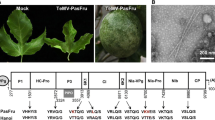Abstract
The complete genome sequence of a virus from lily (Lilium lancifolium Thunb.) growing in Huoshan County, Anhui Province, China, was determined. The whole genome consists of 9558 nucleotides, excluding the poly(A) tail, and encodes a 3061-amino-acid polyprotein (GenBank number ON365558) typical of potyviruses. This is the first complete genome sequence of iris potyvirus B (IPB), for which only a partial sequence from Iris domestica was reported previously. Comparative analysis of this genome sequence with those of closely related potyviruses identified nine cleavage sites and the conserved motifs typical of potyviruses. The complete polyprotein ORF shares 73.6% nucleotide and 81.6% amino acid sequence identity with that of iris potyvirus A (IPA, GenBank number MH898493). Phylogenetic analysis showed that IPB is related to IPA and clusters in a group with lily yellow mosaic virus (LYMV). This is the first report of IPB infecting lily plants.


Similar content being viewed by others

Data availability
The dataset generated during the current study is available in the GenBank database (accession no. ON365558).
References
Li Y, Jia A, Qiao Y, Xiang J, Zhang Y, Wang W (2018) Virome analysis of lily plants reveals a new potyvirus. Arch Virol 163:1079–1082
Zhao K, Yin Y, Hua M, Wang S, Mo X, Yuan E, Zheng H, Lin L, Chen H, Lu Y, Chen J, Peng J, Yan F (2021) Pod pepper vein yellows virus, a new recombinant polerovirus infecting Capsicum frutescens in Yunnan province, China. Virol J 18:42
Adams MJ, Antoniw JF, Beaudoin F (2005) Overview and analysis of the polyprotein cleavage sites in the family Potyviridae. Mol Plant Pathol 6:471–487
Chung BY, Miller WA, Atkins JF, Firth AE (2008) An overlapping essential gene in the Potyviridae. Proc Natl Acad Sci USA 105:5897–5902
Valli A, López-Moya JJ, García JA (2007) Recombination and gene duplication in the evolutionary diversification of P1 proteins in the family Potyviridae. J Gen Virol 88:1016–1028
Atreya CD, Pirone TP (1993) Mutational analysis of the helper component-proteinase gene of a potyvirus: effects of amino acid substitutions, deletions, and gene replacement on virulence and aphid transmissibility. Proc Natl Acad Sci USA 90:11919–11923
Riechmann JL, Laín S, García JA (1992) Highlights and prospects of potyvirus molecular biology. J Gen Virol 73(Pt 1):1–16
Dougherty WG, Parks TD, Cary SM, Bazan JF, Fletterick RJ (1989) Characterization of the catalytic residues of the tobacco etch virus 49-kDa proteinase. Virology 172:302–310
Chen L, Anane RF, Wang Z, Yang L, Chen Z, Wen G, Zhao M (2020) Whole-genome sequence analysis of paris virus 1: a novel member of the genus Potyvirus infecting Paris polyphylla var. yunnanensis. Arch Virol 165:985–988
Adams MJ, Antoniw JF, Fauquet CM (2005) Molecular criteria for genus and species discrimination within the family Potyviridae. Arch Virol 150:459–479
Wylie SJ, Adams M, Chalam C, Kreuze J, Lopez-Moya JJ, Ohshima K, Praveen S, Rabenstein F, Stenger D, Wang AM, Zerbini FM, Consortium IR (2017) ICTV virus taxonomy profile: Potyviridae. J Gen Virol 98:352–354
Kumar S, Stecher G, Li M, Knyaz C, Tamura K (2018) MEGA X: molecular evolutionary genetics analysis across computing platforms. Mol Biol Evol 35:1547–1549
Acknowledgments
We thank Professor Mike Adams for manuscript correction.
Funding
This work was financially supported by the National Key R&D Program of China (2019YFD1001800). This work also was supported by the K. C. Wong Education Foundation.
Author information
Authors and Affiliations
Contributions
QL, QH, and YL conceived and designed the experiments. DY, YY, and QH collected the samples. MH and HZ performed the experiments. YL and JC analyzed the data. QL, DY, and FY wrote the paper. All authors read and approved the final manuscript.
Corresponding authors
Ethics declarations
Conflict of interest
The authors declare that they have no conflict of interest.
Ethical approval
This article does not contain any studies with human participants or animals performed by any of the authors.
Additional information
Handling Editor: Stephen John Wylie.
Publisher's Note
Springer Nature remains neutral with regard to jurisdictional claims in published maps and institutional affiliations.
Supplementary Information
Below is the link to the electronic supplementary material.
Rights and permissions
About this article
Cite this article
Lin, Q., Yan, D., Hua, M. et al. Complete genome sequence of iris potyvirus B infecting Lilium lancifolium in China. Arch Virol 167, 2391–2393 (2022). https://doi.org/10.1007/s00705-022-05539-y
Received:
Accepted:
Published:
Issue Date:
DOI: https://doi.org/10.1007/s00705-022-05539-y



